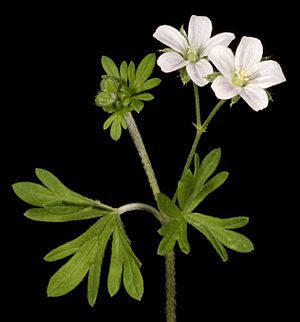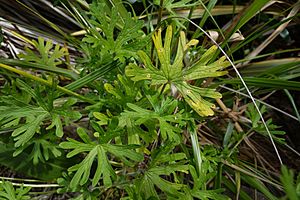Geranium solanderi facts for kids
Quick facts for kids Geranium solanderi |
|
|---|---|
 |
|
 |
|
| Conservation status | |
|
Invalid status (NZ TCS)
|
|
| Scientific classification | |
| Genus: |
Geranium
|
| Species: |
solanderi
|
| Synonyms | |
|
Geranium carolinianum var. australe (Benth.) Fosberg |
|
Geranium solanderi is a type of plant often called the native geranium or Australian cranesbill. It's also known as Austral cranesbill, Cut-leaf cranesbill, native carrot, and hairy geranium. This plant belongs to the Geraniaceae family.
You can find Geranium solanderi growing naturally in Australia. It lives in many states like New South Wales, Queensland, Victoria, South Australia, Western Australia, and Tasmania. It also grows in New Zealand.
Contents
How it got its name
This plant was first described in 1800 by a scientist named Daniel Solander. He called it Geranium pilosum. However, that name had already been used for another plant in 1787.
So, in 1965, another scientist named Roger Charles Carolin gave it a new name: Geranium solanderi. The "solanderi" part of the name honors Daniel Solander, who first found and described the plant in New Zealand.
What Geranium solanderi looks like
Geranium solanderi is a plant that lives for many years. It spreads out along the ground, but its ends grow upwards.
Stems and roots
The stems of the plant can grow up to 50 centimeters (about 20 inches) long. They are covered in coarse, rough hairs. The main root, called a taproot, is often swollen and looks a bit like a turnip.
Leaves
The leaves on the flowering stems grow in pairs. They are shaped like a hand with several deep cuts or lobes. These leaves are usually 1 to 3 centimeters long and 1.5 to 5 centimeters wide. Each leaf has 5 to 10 lobes and is hairy. They grow on a stalk, called a petiole, which can be up to 5 centimeters long.
Flowers and fruits
The flowers usually grow in pairs, though sometimes you might see a single flower. Each pair of flowers grows on a stalk called a peduncle, which is 1 to 4 centimeters long. Each individual flower has its own smaller stalk, called a pedicel, about 2.5 to 5 centimeters long.
The sepals, which are like small leaves protecting the flower bud, are 5 to 9 millimeters long. The petals are pink and are 5 to 12 millimeters long. Often, you can see yellowish veins on the pink petals. The parts of the flower that hold pollen, called anthers, are yellow. After the flowers bloom, they produce fruits that are 12 to 25 millimeters long. Inside these fruits are black seeds.
Conservation status
In New Zealand, scientists keep track of how many of these plants are left. In 2004 and 2009, Geranium solanderi was considered "Not threatened." This meant there were plenty of them.
However, in 2012, under the New Zealand Threat Classification System, its status changed. It was then listed as "At Risk - Declining." This means the number of these plants was starting to go down. This status was confirmed again in 2017. The plant is still considered "safe overseas" (SO) and "data poor" (DP), meaning more information is needed.
Traditional uses
The Noongar people, who are Indigenous Australians from the southwest part of Western Australia, used this plant. They would cook the older, red, tuber-like roots. After cooking, they used these roots as a traditional medicine to help treat diarrhea.

